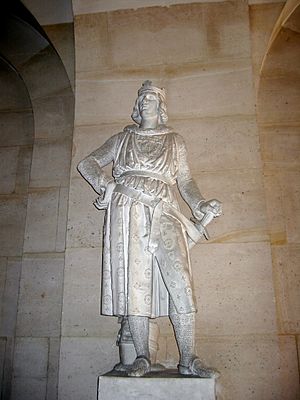Robert III of Artois facts for kids
Quick facts for kids Robert III of Artois |
|
|---|---|
| Count of Beaumont-le-Roger Lord of Conches-en-Ouche, Domfront and Mehun-sur-Yèvre |
|
 |
|
| Statue of Robert d'Artois in Versailles | |
| Spouse(s) |
Joan of Valois
(m. 1320) |
| Issue | |
| John, Count of Eu Charles, Count of Pezenas |
|
| Noble family | Artois |
| Father | Philip of Artois |
| Mother | Blanche of Brittany |
| Born | 1287 |
| Died | 1342 (aged 54–55) |
Robert III of Artois (1287 – between 6 October & 20 November 1342) was an Artesian nobleman of the House of Artois. He was the Lord of Conches-en-Ouche, of Domfront, and of Mehun-sur-Yèvre, and in 1309 he received as appanage the county of Beaumont-le-Roger in restitution for the County of Artois, which he claimed. He was also briefly Earl of Richmond in 1341 after the death of John III, Duke of Brittany.
Contents
Life
Origin
Robert was the son of Philip of Artois, Lord of Conches-en-Ouche, and Blanche of Brittany, daughter of John II, Duke of Brittany. Both were male descendants of the Capetian dynasty. His father died on 11 September 1298 from wounds received at the Battle of Furnes on 20 August 1297 against the Flemish. His father's early death was an indirect cause of the dispute over the succession to the County of Artois.
Guardianship
After the death of his grandfather, Robert II, Count of Artois, at the Battle of Courtrai in 1302, his grandfather's daughter, Mahaut of Artois, inherited the County of Artois by custom, as she was his eldest child. Robert was too young to challenge his aunt Mahaut and claim the rights he had inherited from his father. He would do so later. The rancour and intrigue between Mahaut (sometimes called Mathilde) and Robert took place during a period of conflict between France and England before the Hundred Years' War.
Influence
Robert played an important role in the succession to the throne of his brother-in-law Philip VI of France and was his trusted advisor for some time. It was through this influence that Philip VI granted him the county of Beaumont-le-Roger from in June 1328 as compensation for Mahaut's inheritance of Artois. On Mahaut's death in 1329, the title passed to her daughter, Joan II, Countess of Burgundy. Following the example of the county of Flanders, Robert reopened the question of succession.
The fraudulent will
However, in 1329, Robert through the use of thirty-four perjured depositions and a forgery created by Jeanne de Divion which attested to the will of his father. This deception was discovered and Robert lost any hope of acquiring Artois. The forger Divion was burned at the stake. After failing to respond to a fourth summons to appear before Philip, Robert was sentenced to exile and estate confiscation by Philip VI on 8 April 1332. To avoid arrest and execution, Robert fled France in 1332 and took refuge with his nephew, John II, Marquis of Namur. His wife and sons John and Charles were imprisoned at Chateau Gaillard in Normandy in 1334. Philip VI then asked the Bishop of Liège to attack Namur. Robert again fled to his nephew-in-law, John III, Duke of Brabant. Once again, King Philip VI's influence led to a war against Brabant and Robert was again exiled, this time to England.
Refuge in England
Robert met Edward III of England and urged the English king to go to war to reclaim the kingdom of France. While in England, Robert became a member of King Edward's royal council and provided the English king with extensive information about the French court. Many contemporary chroniclers relate how Robert's influence led directly to the start of the Hundred Years' War, particularly because King Philip VI cited King Edward III's unwillingness to expel Robert as the reason for confiscating the Duchy of Aquitaine in May 1337. In the late 1340s, a poetic oath called the Voeux du héron (Vow of the Heron) circulated in France and England, depicting Edward III's invasion of France as the fulfilment of a chivalric oath made to Robert to take the French throne as his dynastic right.
Robert then followed King Edward III on his campaigns, including commanding the Anglo-Flemish army at the Battle of Saint-Omer in 1340.
Breton War of Succession
Robert finally succumbed to dysentery after being wounded during the retreat from the city of Vannes in November 1342, during the War of the Breton Succession. He was originally buried in Blackfriars Church in London, although his tomb is now in St Paul's Cathedral.
Family
Around 1320 Robert married Joan, daughter of Charles of Valois and his second wife Catherine I of Courtenay. They had:
- Louis (1320–1326/29).
- John (1321–1387), Count of Eu.
- Joan (1323–1324).
- Jacques (c. 1325–1347).
- Robert (c. 1326–1347).
- Charles (1328–1385), Count of Pezenas.
In fiction
Robert III of Artois is a major character in Les Rois maudits (The Accursed Kings), a series of French historical novels by Maurice Druon in which many of these events are retold. He was played by Jean Piat in the 1972 French miniseries adaptation of the series, and by Philippe Torreton in the 2005 adaptation.
See also
- List of works by James Pradier
Sources
155
| Peerage of England | ||
|---|---|---|
| Preceded by John III of Brittany |
Earl of Richmond 1341–1342 |
Succeeded by John of Gaunt |

